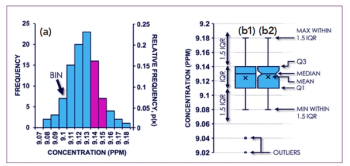Key Points
- Molecular simulations have become powerful tools for biomolecule analysis, though due to technical complexities, this approach is limited in usability.
- Workflow management systems have been suggested as viable means of simplifying this process, and the researchers tested their potential in this regard.
- In this study, researchers examined two workflow management systems that proved effective, thus making molecular simulations a more accessible and effective means of analyzing biomolecules.
Researchers from the Karlsruhe Institute of Technology in Eggenstein-Leopoldshafen, Germany used workflow management systems to simplify chromatographic biomolecule analysis. Their findings were published in the Journal of Chromatography A (1).
Molecular simulations are a powerful tool, offering insights into the interactions between biomolecules and resin surfaces at an atomic level. However, despite their potential and progress, widespread integration into chromatographic research has been limited. A primary obstacle is the technical complexity behind setting up and running the molecular simulations, which call for specialized expertise and significant computational resources. These barriers have restricted molecular simulations’ usability within chromatography, highlighting the need for more accessible and user-friendly methodologies.
Workflow management systems have become viable solutions. These systems are sophisticated software environments designed to automate simulations and data management. These programs enable the scheduling and parallel processing of individual tasks while supporting workflows with flexible designs. Further, workflow management systems simplify the execution of complex simulations, offering user-friendly interfaces that allow researchers to engage with advance molecular modeling, regardless of their computational knowledge. Workflow management systems enable experienced researchers to share advanced simulation methodologies with newer researchers, increasing accessibility and broadening the technologies' applications.
In this study, two workflow management systems, SimStack and KNIME, were used to automate complex multistage modeling workflows to streamline molecular modeling in chromatography. This builds upon the researchers’ previous efforts, where they introduced and validated a virtual design approach for generating all-atom models of methacrylate-based chromatography resin surfaces, inclusive of the backbone structure (2). SimStack is a system meant to facilitate efficient implementation, adoption, and execution for complex and extensive simulation workflows (3). The KNIME software platform is meant for end-to-end data science, from creating analytic methods, to deploying and sharing insights within an organization (4).
Using SimStack, the scientists automated the creation of bespoke all-atom resin surface models (AAM). By integrating commonly used ion-exchange ligands, short spacer molecules, and methacrylate-based monomers into the workflow, the scientists were able to simulate a broad spectrum of chromatography resins and modes. The KNIME-automated workflow was used to rapidly calculate binding poses and binding free energies between linear peptides and the previously generated AAM. The automated workflows improved the researcher’s ability to simulate a wide range of biomolecular interactions, they reported.
By making these workflows publicly available, the researchers hope to encourage the chromatography community to build upon their findings and discover new breakthroughs during this process. Users can design novel resin materials, more accurately predict complex interactions with various biomolecules and refine separation processes. In the future, the scientists hope for these workflows to be adapted and expanded further, broadening their utility across different aspects of chromatographic research and solidifying molecular simulation as a cornerstone of modern chromatographic analysis.
References
(1) Ballweg, T.; Liu, M.; Mama, A.; Wenzel, W.; Franzreb, M. Molecular Insights into Chromatography: Automated Workflows for the Virtual Design of Methacrylate-Based Chromatography Resins. J. Chromatogr. A 2025, 1754, 466027. DOI: 10.1016/j.chroma.2025.466027
(2) Ballweg, T.; Liu, M.; Grimm, J.; Sedghamiz, E.; Wenzel, W.; Franzreb, M. All-Atom Modeling of Methacrylate-Based Multi-Modal Chromatography Resins for Langmuir Constant Prediction of Peptides. J. Chromatogr. A 2024, 1730, 465089. DOI: 10.1016/j.chroma.2024.465089
(3) About SimStack. SimStack 2025. https://www.simstack.de/ (accessed 2025-6-11)
(4) KNIME Software. KNIME 2025. https://www.knime.com/software-overview (accessed 2025-6-11)





